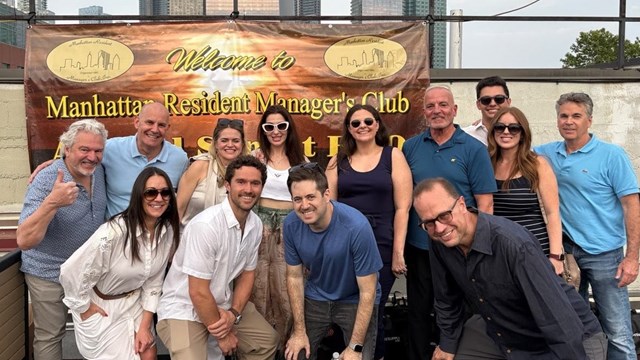
On October 22, several hundred hurricane evacuees descended on Brooklyn’s New York City College of Technology. The school had been temporarily converted into an evacuation center, where refugees were screened before being sent to shelters that had been set up in two nearby Department of Education buildings. And all this occurred despite the fact that there was no hurricane anywhere near New York City this October.
The event, called Hurrex, was a field exercise hosted by the New York City Office of Emergency Management (OEM). A seven-hour ordeal in which up to 30 agencies and upwards of 800 people participated, Hurrex was the third in a series of drills designed to test the city’s Coastal Storm Plan, which aims to mitigate the detrimental effects of a major hurricane strike. Alarmingly, big hurricanes are not unknown to New York—a devastating storm made landfall most recently in 1938—and many experts cite the city’s long coastline and high population density as factors that could exacerbate the destruction posed by a similar disaster.
According to OEM spokesman Andrew Troisi, “[Hurrex is] part of a continuing series of exercises that we perform; they’re interagency exercises where OEM will coordinate the planning, but you’ll have scores of agencies participating, oftentimes numbering up to 50.”
OEM prides itself in preparing New York for serious eventualities, but that’s only one of the agency’s responsibilities. Its multi-faceted mission encompasses not only preparation for emergencies, but coordinating the City’s emergency response, directing recovery efforts, and educating the public.
World War Roots
OEM traces its history back to the Second World War, although today’s agency bears only slight resemblance to its earliest predecessors. In 1941, President Roosevelt named New York City Mayor Fiorello LaGuardia director of the newly minted federal Office of Civil Defense (OCD). The short-lived bureau concerned itself with organizing the populace to defend itself against enemy air raids and their attendant destructive effects, chiefly fire. Lacking direction, it fizzled out in 1945.
It wasn’t until April of 1950 that New York City formed its own local version of the OCD. Inspired by the Cold War, this OCD’s job was to gird the city for an atomic bomb attack and coordinate its civil defense efforts with those of surrounding counties and other municipalities.
1961 saw the emergence of the Mayor’s Emergency Control Board (MECB), a kind of cabinet that helped advise the mayor in times of crisis and which included the leaders of the Police, the Fire Department, and the Health and Hospitals Corporation. In the late 1960’s, the MECB began developing disaster preparedness plans, and the Board soon combined with the erstwhile OCD to form the Office of Emergency Control Board—Civil Defense, the first city agency to concentrate on formulating response plans to all kinds of disasters and emergencies.
Mayor Rudy Giuliani laid the groundwork for the modern OEM in 1996 by creating the Mayor’s Office of Emergency Management. His executive order removed emergency management responsibilities from the NYPD and established the new agency as a branch of the mayor’s office, putting its director in charge of civil defense and disaster preparedness. In a 2001 referendum, voters made the agency an independent, department-level organization headed by a commissioner, changing its name to OEM.
Leadership
Joseph F. Bruno, the fourth commissioner in OEM’s modern history, has led the agency since 2004. Having previously served as a trial lawyer for the City Law Department, a City Civil Court judge, a State Supreme Court judge, and FDNY Commissioner during the Koch administration, Bruno arrived at OEM having assembled an impressive record of local civil service that goes back to 1971.
Bruno’s tenure at OEM has been marked by some notable successes, policy advances and competent responses to controversial crises. OEM helped keep the city calm during the 2005 transit strike, when New Yorkers were without subway and bus service for three days. OEM also helped maintain order in the face of mounting citizen frustration during the Queens blackout last summer, during which tens of thousands of residences and businesses had no electrical power for more than a week. While the MTA, Con Edison and Mayor Michael R. Bloomberg absorbed most of the heat for those unpopular incidents, OEM quietly helped keep those situations from spinning out of control.
In addition to OEM’s reactive performances, the last couple of years under Commissioner Bruno have seen the agency make significant progress in hazard preparation. The aforementioned Coastal Storm Plan, revised and continually tested this year, provides contingencies for sheltering up to 600,000 residents in the event of a “worst case scenario” hurricane.
In 2005, the city adopted the City Incident Management System (CIMS), a playbook for coordinating multi-agency responses to both manmade and natural disasters, in addition to large-scale events like major party political conventions. OEM has also been active in sending help to disaster areas around the globe, including the hurricane-ravaged Gulf Coast and tsunami-battered portions of South Asia.
Of course, OEM isn’t a one-man show. Joining Commissioner Bruno in the agency’s executive leadership are First Deputy Commissioner Calvin Drayton, an agency vet since 1996 who now heads OEM’s operations divisions; Chief of Staff Seth Cummins, who directs the agency’s Public Information programs and other outreach organs; Deputy Commissioner for Operations Brad Gair, who previously served as FEMA’s Federal Coordinating Officer for New York City; Deputy Commissioner for Planning and Preparedness Kelly McKinney; General Counsel Stella Guarna; and Deputy Commissioner for Finance, Policy and Administration Rachel Stein Dickinson.
Preparing the City
The first of OEM’s three principal duties is to prepare contingencies that that will see New York City through any number of incidents, expected or otherwise. In addition to natural disaster approaches like the Coastal Storm Plan, OEM has developed situational strategies to deal with events like utility failures and large-scale demonstrations. In order to make sure these plans are battle ready, OEM periodically runs drills and exercises—like Hurrex—that can identify which tactics are working smoothly and which ones still need reevaluation.
Sometimes, even terrible events foster the creation of beneficial programs. In the aftermath of the 9/11 attacks, it became clear that New York needed a way to locate and keep track of assets, both city- and privately- owned, that would prove indispensable in the face of unthinkable catastrophes. As a result, OEM developed the Citywide Asset and Logistics Management System (CALMS), a database that keeps track of city government resources—think heavy equipment such as large cranes and the like—that would need to be procured and relocated quickly in case of a major incident. CALMS’ sister program, PALMS, keeps a similar database of privately owned assets; businesses volunteer their resources and provide OEM with a 24-hour contact so that critical equipment can be commandeered at a moment’s notice.
Responding to Emergencies
While it’s departments like NYPD and FDNY that handle the hands-on, down and dirty work at the scenes of incidents like fires, explosions and building collapses, OEM’s job is to help the other responding agencies integrate their efforts effectively. “We’re a coordinating agency,” says Triosi, “so in almost every hazard we perform a support role.”
For example: the fire department takes charge when there’s an elevator emergency, the police are in command during a bomb threat, and a larger event like a utility disruption requires that both agencies jointly tackle the problem, with the help of Keyspan or Con Ed.
It’s incidents like the latter that especially necessitate OEM’s coordinating expertise. Field operatives are dispatched to the scene, sometimes accompanied by one or more of the agency’s response vehicles. These include the Interagency Command Vehicle, a converted ambulance decked out with communications equipment, and the Interagency Command Center, a rolling behemoth outfitted with computers, surveillance equipment, a telephone system, and a briefing room. For incidents like major disasters or planned large-scale events (such as the 2004 GOP convention), OEM activates its Emergency Operations Center (EOC). Located at OEM headquarters, the EOC serves as a staging ground where officials from federal, state and local agencies can convene to communicate and make decisions.
Informing the Public and Beyond
Perhaps OEM’s most important function—a notion reinforced by a quick glance at the agency’s website—is keeping ordinary New Yorkers educated about and prepared for “all types of emergencies.” At the forefront of this effort is OEM’s Ready New York program, which simply and carefully explains why regular folks should prepare themselves for extraordinary circumstances, and more importantly, how they can do so.
Ready New York calls on citizens to equip their homes with an emergency supply kit containing enough food and water per person for three days, formulate a Household Disaster Plan spelling out how family members can find each other and communicate in an emergency, and prepare a “Go Bag”—a sturdy case containing everything a person would need in case of evacuation. Such items include copies of irreplaceable documents, cash, a flashlight, and bottled water.
OEM realizes that many people, in addition to helping out themselves and their loved ones, often rush to help strangers in traumatic times. With this in mind, they’re created the Community Emergency Response Team (CERT) program, which aims to collect neighborhood groups of good Samaritans and train them in first aid, fire safety and light search and rescue. CERT volunteers won’t replace first responders like paramedics and firefighters, but they will know how move people trapped under a piece of debris (or how not to move them) and how to treat minor wounds.
OEM appears well organized, yet always seems to strive for newer and more efficient ways to bolster New York for the worst; their forthcoming Continuity of Operations program—providing for the maintenance of critical city functions during emergencies—being just one example. If OEM has one conspicuous trait, it’s the apparent understanding that when it comes to emergency management for a city like New York, complacency isn’t an option.
Shek Baker is a freelance writer living in Brooklyn.





Leave a Comment